Deleted
Deleted Member
Posts: 0
|
Post by Deleted on Feb 5, 2018 18:21:45 GMT -5
Magical new 4,500 year old finds add to 'oldest toy collection in the world' siberiantimes.com/science/casestudy/news/magical-new-4500-year-old-finds-add-to-oldest-toy-collection-in-the-world/An ancient doll and a mythical animal were buried with a child from the Okunev culture in the Bronze Age. 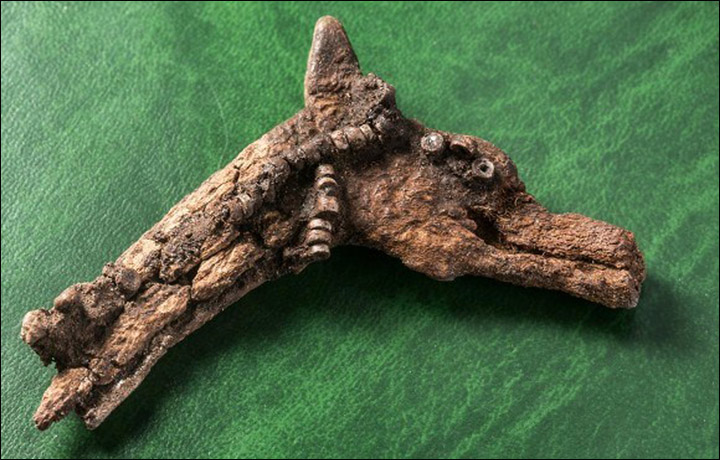 The toy animal head is made from antler or horn. Picture: IIMK RAS The toy animal head is made from antler or horn. Picture: IIMK RASThe rare discoveries of the pre-historic toys were made at the Itkol II burial ground in the Republic of Khakassia, southern Siberia. The doll had ‘carefully worked out facial features’ and was made of soapstone - a soft rock made mostly of talc, said archeologist Dr Andrey Polyakov, from the Institute of History of Material Culture in St Petersburg. The head of the doll is around 5 centimetres tall. 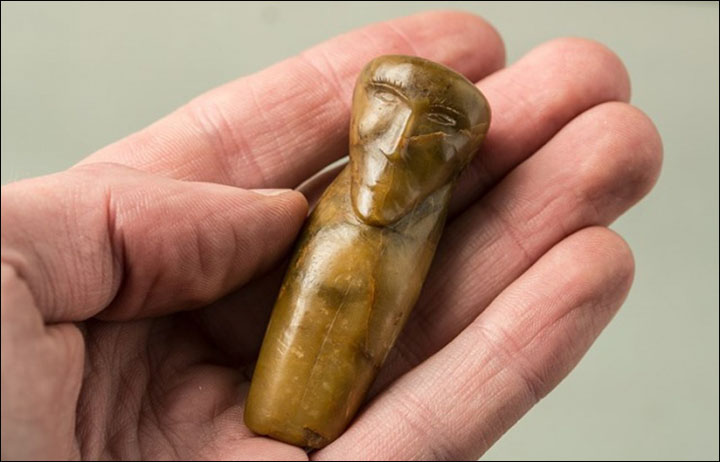 The doll had ‘carefully worked out facial features’ and was made of soapstone. Picture: IIMK RAS The doll had ‘carefully worked out facial features’ and was made of soapstone. Picture: IIMK RASThe toy animal head is made from antler or horn. Experts are as yet unsure what animal it depicts but it is perhaps mythical. In both cases the bodies of the toys were made from organic material and did not preserve. The finds were made in the grave of a ‘common child’ - not an elite burial, said Dr Polyakov.
|
|
Deleted
Deleted Member
Posts: 0
|
Post by Deleted on Feb 5, 2018 18:30:37 GMT -5
Magical new 4,500 year old finds add to 'oldest toy collection in the world', part 2.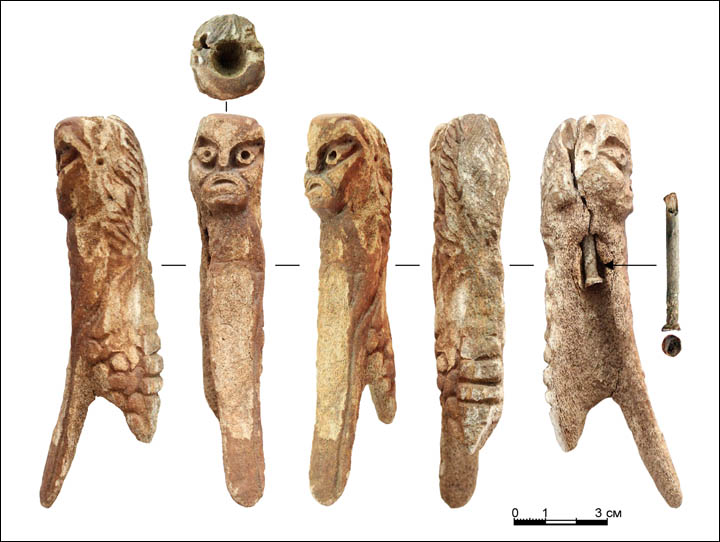 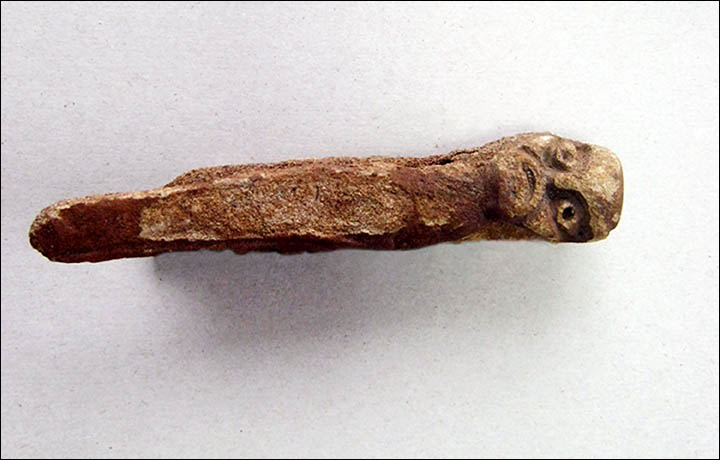 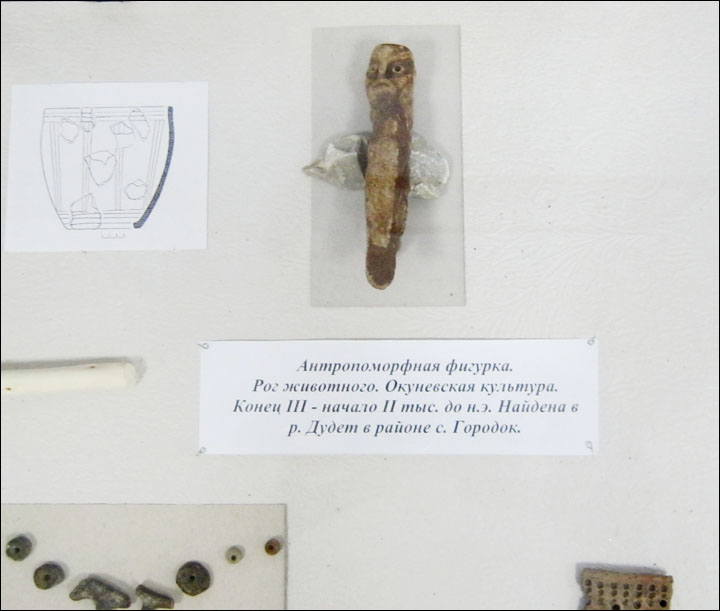 A figurine of a pagan god pulled out of a Siberian river by an angler was likely a child’s toy or rattle to ward off evil spirits. Picture: Pavel German & Vladimir Bobrov, Tisul History museum A figurine of a pagan god pulled out of a Siberian river by an angler was likely a child’s toy or rattle to ward off evil spirits. Picture: Pavel German & Vladimir Bobrov, Tisul History museumThe Okunev culture is seen as having links to Native Americans - and this is not the first time their toys have been found. Indeed, the latest finds add to an intriguing collection. A figurine of a pagan god pulled out of a Siberian river by an angler was likely a child’s toy or rattle to ward off evil spirits. It has almond-shaped eyes, a large mouth with full lips, and a ferocious facial expression. On the back is 'plaited hair with wave like lines. Below the plait there are lines looking like fish scales.' Fisherman Nikolay Tarasov made ‘the catch of a lifetime’, said museum staff. 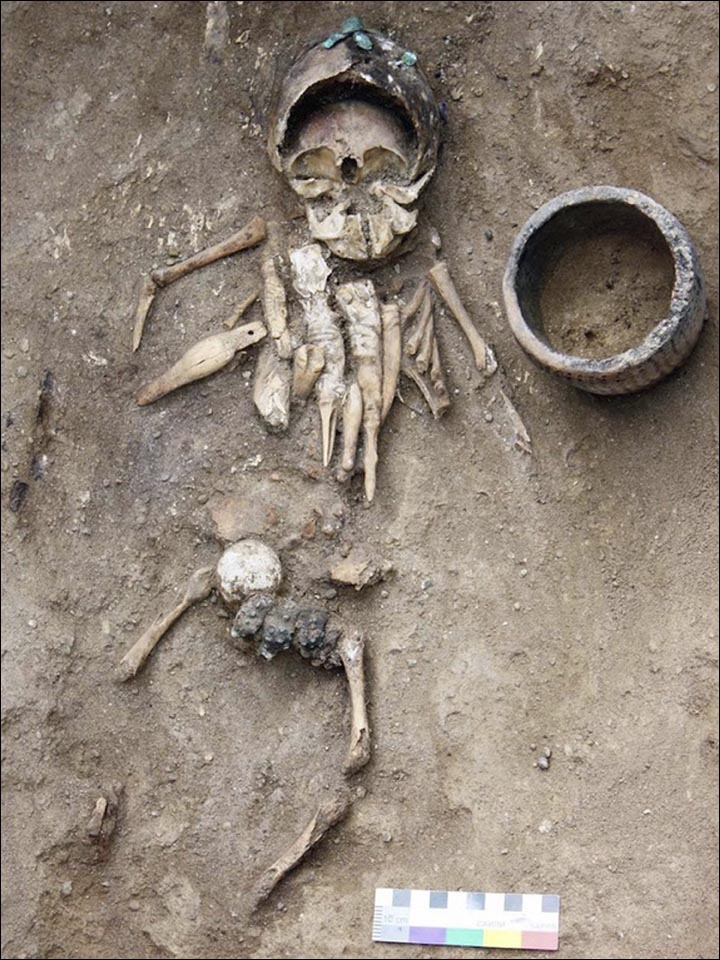 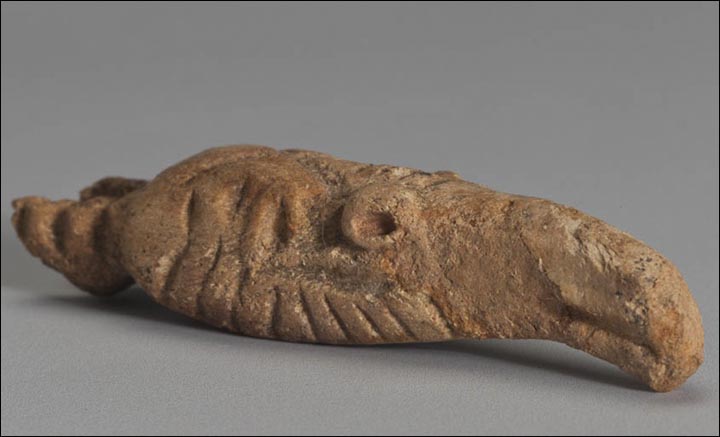 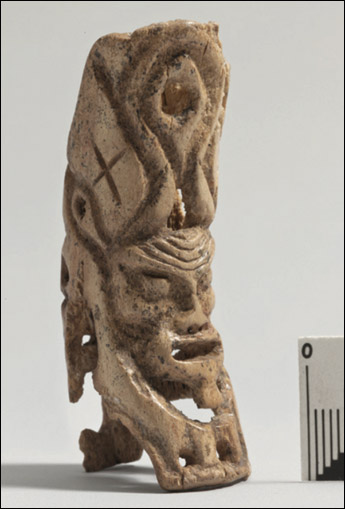 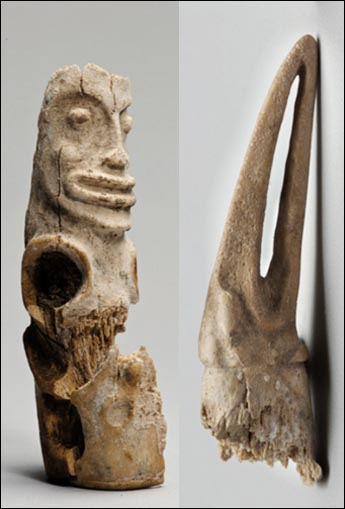 Eight intricately carved figurines with the faces of humans, birds, elk and a boar lay on the chest of the ancient infant. Pictures: Andrey Polyakov & Yuri Esin Eight intricately carved figurines with the faces of humans, birds, elk and a boar lay on the chest of the ancient infant. Pictures: Andrey Polyakov & Yuri EsinMeanwhile a collection of ghoulish figurines discovered with a baby’s remains in a birch-bark cradle two years ago have been hailed as the oldest rattles ever found. Eight intricately carved figurines with the faces of humans, birds, elk and a boar lay on the chest of the ancient infant. Each was up eight centimetres long. This discovery was made on the northwest short of Lake Itkul. Words and pics from The Siberian Times.siberiantimes.com/science/casestudy/news/magical-new-4500-year-old-finds-add-to-oldest-toy-collection-in-the-world/
|
|
Deleted
Deleted Member
Posts: 0
|
Post by Deleted on Feb 12, 2018 1:28:16 GMT -5
The Coins of the Huns and Western Turks in Central Asia and India.
Kidarite Coin:
 Kidara, King of the Kushan (4th/5th c. CE) DENOMINATION: Dinar (Gold) MINT Balkh OBVERSE: King with palmette crown in Sasanian military dress sacrificing at an altar.  REVERSE: Iranian god Oesho before a bull (corrupted style) Hephthalites (A.K.A. White Huns) Clay seal of a Hephthalite king with the Bactrian inscription "The Lord (Yabgu) of the Hephthalites". End 5th/first half of the 6th century CE. Link with further intriguing coins and info: pro.geo.univie.ac.at/projects/khm/?language=en
|
|
Deleted
Deleted Member
Posts: 0
|
Post by Deleted on Feb 16, 2018 17:27:07 GMT -5
Here's an interesting movie from the land of Olonkho.
Tual Baarun Tukaru (While the Wind Blows) with subs in English.
Description:
Touted as the first feature film from the Sakha (Yakut) region of Russia, and the imagineNATIVE debut of young Yakut director Sergei Potapov, Tual baarun tukaru is a cinematic and mythic tour de force of good vs. evil, and a new voice in Indigenous film. In the rural expanse of the Russian wilderness, a mysterious storyteller wanders upon the feudal enclave of the Moyos family and their servants. Aiyyna, the beautiful daughter of Lord Moyos, is transfixed by the storyteller and dreaming of her future when she is abducted by Ehr Sogotokh, a lonely and mysterious castaway. Aiyyna’s fiance, Sette Timekh, son of the regional duke, mounts a campaign to rescue his lover and hunt down her captor with a squad of warriors. But meeting with Ehr changes Aiyya’s life. Reliving his strange upbringing, Ehr understands his destiny and that the battle for Aiyyna may be his last. Jealousy, betrayal and yearning test heroes and villains, a showdown between love and death. Sumptuous cinematography, landscapes and distinctive storytelling make this Beauty and the Beast tale a magical and memorable film. This is the first feature for Sergei Potapov (Sakha). Born in the village of Suntar in the Yakutia region of eastern Russia, Sergei created several short documentary and dramatic works such as Breath, Once in Yakutsk and Whims of Rain before establishing with fellow filmmakers the Cinema Centre Production company in 2009. In production since then, this is the company’s first large-scale production. The film screened to local audiences in Yakutsk before making its international debut at imagineNATIVE.
|
|
Deleted
Deleted Member
Posts: 0
|
Post by Deleted on Feb 22, 2018 14:49:32 GMT -5
Gyorgy Kara, Books of the Mongolian Nomads: More than Eight Centuries of Writing Mongolian, Indiana University Press, 2005.I picked this up a couple of weeks ago. It is a little heavy going at times, but, still an intriguing read. Of course, now with the recently deciphered Khüis Tolgoi Inscriptions we have the earliest extant writing in the Mongolian language from the late 6th century. Link to Khüis Tolgoi Inscription: swordsofreh.proboards.com/post/15008/  Description: Description:
The fascinating story of the visualized languages, alphabets, and other writing systems, hand-written and block-printed books of the Mongols, Kalmyks, Buryats, and other Mongolian nations is outlined in this study by one of the world's preeminent scholars of the region. The mostly nomadic peoples of the Mongolian language family have a long history of letters. The Khitans had two writing systems, both of Chinese inspiration and still not fully deciphered. In Chinggis Khan's world empire and in the later Mongolian societies, a number of various alphabets of Mediterranean and Indo-Tibetan origin were used alternatively, according to the needs and caprices of faith and political power. Similarly, the contents and shapes of books and related monuments, the loose "palm leaves," the accordion-style and the double-leaved "notebook" forms, scrolls, stone inscriptions, and seals reflect the complex cultural history of the Mongols of Mongolia, China, and European and Asiatic Russia.
|
|
Deleted
Deleted Member
Posts: 0
|
Post by Deleted on Feb 25, 2018 2:59:50 GMT -5
The Chinggis Stone A.K.A. the Yesüngge Inscription dates from around 1225 after the Mongol victory over the Empire of Khwarazm.  Here's an English translation of the inscription (based on the translation by Radloff) When Chinggis Khan subdued the Sartaul People, set up his camp and convoked the commanders of the All-Mongolian Empire at Buka-Sochigai, Yesüngge made a long shot: he shot [an arrow] to three hundred and thirty-five alds.The Sartaul People in the inscription are the unfortunate Khwarazmians. Sartaul or Sart is a term applied to the sedentary people of Middle-Eastern and Central Asian origin by the nomadic Turko-Mongol tribes. It is also applied in a somewhat derogatory fashion to Turko-Mongol groups/nations that betray their nomadic/tribal heritage and adopt a sedentary lifestyle - the term is still in use to this day! Yesüngge is the son of Qasar, and nephew of the Great Genghis Khan. The Ald is an old Mongolian unit of measure said to be one-arm-span in length (just over 1.6 metres according to wikipedia) 335 alds works out as a total distance of over 536 meters! At least! Wiki links of interest: en.wikipedia.org/wiki/Vasily_Radloven.wikipedia.org/wiki/Sarten.wikipedia.org/wiki/Ald_(unit) |
|
Deleted
Deleted Member
Posts: 0
|
Post by Deleted on Mar 5, 2018 2:49:54 GMT -5
Here's a great link where you can find selected historical translations concerning Central Asia and the Warriors of the Steppe. You can find the history of the Uyghurs according to the Tang Dynasty. The Hunnu and the Yuezhi according to Han chroniclers, ancient Soghdian letters, Giovanni da Pian del Carpine and William of Rubruck, the monks that travelled all that way across the Eurasian steppe to meet the Great Khans of the Mongols. We can also find Rabban Bar Sauma the Turco-Mongol Nestorian Christian heading in the opposite direction to Europe, and the Spanish ambassador Ruy Gonzalez de Clavijo at the court of the mighty Tartar Timür, and loads more  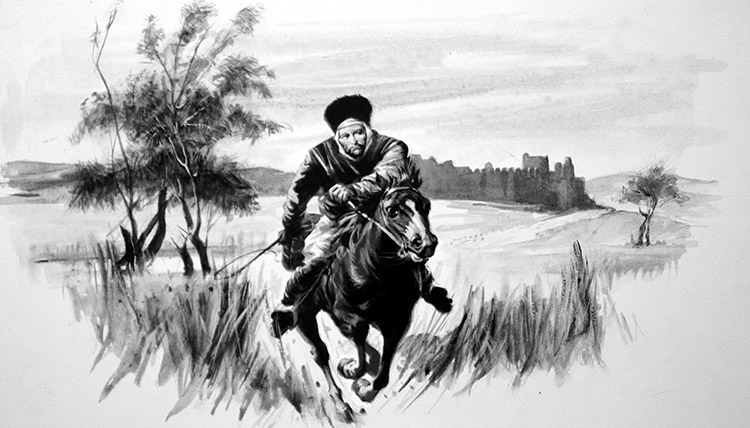 Friar John de Plan Carpini, envoy of Pope Innocent IV. (Art by Ralph Bruce, originally published in Look and Learn #566 18th November 1972) Link: depts.washington.edu/silkroad/texts/texts.html |
|
Deleted
Deleted Member
Posts: 0
|
Post by Deleted on Mar 16, 2018 2:06:29 GMT -5
|
|
Deleted
Deleted Member
Posts: 0
|
Post by Deleted on Mar 19, 2018 17:42:57 GMT -5
The art of Timur Dairbaev.   |
|
Deleted
Deleted Member
Posts: 0
|
Post by Deleted on Mar 21, 2018 1:59:22 GMT -5
Looks very interesting.  Julian Romane, Rise of the Tang Dynasty: The Reunification of China and the Military Response to the Steppe Nomads (AD581-626), Pen & Sword Military, 2018.Description: Julian Romane, Rise of the Tang Dynasty: The Reunification of China and the Military Response to the Steppe Nomads (AD581-626), Pen & Sword Military, 2018.Description:
Julian Romane examines the military events behind the emergence of the Sui and Tang dynasties in the period 581-626 AD. Narrating the campaigns and battles, he analyses in detail the strategy and tactics employed, a central theme being the collision of the steppe cavalry with Chinese infantry armies. By the fourth century AD, horse nomads had seized northern China. Conflict with these Turkic interlopers continued throughout the 5th and most of the 6th century. The emergence of the Sui dynasty (581-618) brought some progress but internal weakness led to their rapid collapse. The succeeding House of Tang, however, provided the necessary stability and leadership to underpin military success. This was largely the achievement of Li Shimin, who later became the second Tang Emperor. By the start of Li Shimin s reign as Emperor Tang Taizong, effective military organizations had been developed and China reunified. His military campaigns are examples of tactical and strategic virtuosity that demonstrate the application of the distinctive Chinese way of war expounded in Chinese military manuals, including Li Shimin s own writings. www.amazon.com/Rise-Tang-Dynasty-Reunification-Military/dp/1473887771/ref=sr_1_1?ie=UTF8&qid=1521615568&sr=8-1&keywords=rise+of+the+tang+dynasty |
|
Deleted
Deleted Member
Posts: 0
|
Post by Deleted on Mar 23, 2018 3:24:06 GMT -5
The Yuezhi: Indo-European neighbours of the Xiongnu (Huns)
We all know about The Yuetshi (Yuezhi) fisherman from 'The Devil in Iron' - but, what about the historical Yuezhi? The historical Yuezhi were the South-Western neighbours of the Xiongnu. To the east of the Xiongnu roamed the Donghu (Eastern Barbarians) Hu was a general term the Chinese used for barbarians. 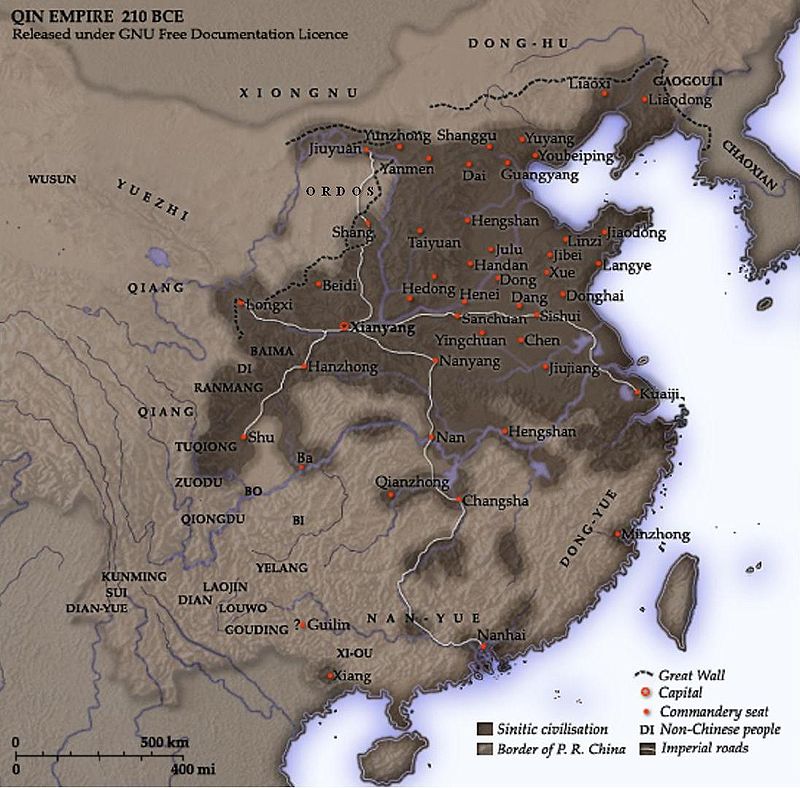 map from wikipedia. The Unusual thing about the Yuezhi is that they probably spoke a Tocharian language, which is believed to be closer to the western Indo-European languages. The king of the Xiongnu, Modu Chanyu (reigned 209BC-174BC) defeated the Yuezhi - the job was finished off by Modu's son, he made a made a drinking cup out of the skull of the Yuezhi king. This set in motion the great migration of the Yuezhi into the heart of Central Asia. The rise of Xiongnu power, was probably the beginning of the expansion of the Altaic languages beyond Mongolia, Manchuria, Northern China and Siberia. A book I'm keen on picking up one day. The Yuezhi. Origin, Migration and the Conquest of Northern Bactria by C. Benjamin  This book provides a detailed narrative history of the dynasty and confederation of the Yuezhi, whose migration from western China to the northern border of present-day Afghanistan resulted ultimately in the creation of the Kushan Empire. Although the Yuezhi have long been recognised as the probable ancestors of the Kushans, they have generally only been considered as a prelude to the principal subject of Kushan history, rather than as a significant and influential people in their own right. The evidence seemed limited and ambiguous, but is actually surprisingly extensive and detailed and certainly sufficient to compile a comprehensive chronological political history of the Yuezhi during the first millennium BCE. The book analyses textual, numismatic and archaeological evidence in an attempt to explain the probable origin of the Yuezhi, their relationship with several Chinese dynasties, their eventual military defeat and expulsion from the Gansu by the Xiongnu, their migration through the Ili Valley, Ferghana and Sogdia to northern Bactria, and their role in the conquest of the former Greco-Bactria state. All of these events were bound up with broader cultural and political developments in ancient Central Asia and show the extraordinary interconnectedness of the Eurasian historical processes. The domino-effect of the migration of the Yuezhi led to significant changes in the broader Eurasian polity. This book provides a detailed narrative history of the dynasty and confederation of the Yuezhi, whose migration from western China to the northern border of present-day Afghanistan resulted ultimately in the creation of the Kushan Empire. Although the Yuezhi have long been recognised as the probable ancestors of the Kushans, they have generally only been considered as a prelude to the principal subject of Kushan history, rather than as a significant and influential people in their own right. The evidence seemed limited and ambiguous, but is actually surprisingly extensive and detailed and certainly sufficient to compile a comprehensive chronological political history of the Yuezhi during the first millennium BCE. The book analyses textual, numismatic and archaeological evidence in an attempt to explain the probable origin of the Yuezhi, their relationship with several Chinese dynasties, their eventual military defeat and expulsion from the Gansu by the Xiongnu, their migration through the Ili Valley, Ferghana and Sogdia to northern Bactria, and their role in the conquest of the former Greco-Bactria state. All of these events were bound up with broader cultural and political developments in ancient Central Asia and show the extraordinary interconnectedness of the Eurasian historical processes. The domino-effect of the migration of the Yuezhi led to significant changes in the broader Eurasian polity. Another book by Craig Benjamin.  Craig Benjamin, Empires of Ancient Eurasia: The First Silk Roads Era, 100 BCE – 250 CE, Cambridge University Press, 2018. Craig Benjamin, Empires of Ancient Eurasia: The First Silk Roads Era, 100 BCE – 250 CE, Cambridge University Press, 2018.
Description:
The Silk Roads are the symbol of the interconnectedness of ancient Eurasian civilizations. Using challenging land and maritime routes, merchants and adventurers, diplomats and missionaries, sailors and soldiers, and camels, horses and ships, carried their commodities, ideas, languages and pathogens enormous distances across Eurasia. The result was an underlying unity that traveled the length of the routes, and which is preserved to this day, expressed in common technologies, artistic styles, cultures and religions, and even disease and immunity patterns. In words and images, Craig Benjamin explores the processes that allowed for the comingling of so many goods, ideas, and diseases around a geographical hub deep in central Eurasia. He argues that the first Silk Roads era was the catalyst for an extraordinary increase in the complexity of human relationships and collective learning, a complexity that helped drive our species inexorably along a path towards modernity.
The first accessible single-volume history of all of ancient Eurasia, offering an account of the major sedentary and nomadic states and empires of the region
Conceptualizes the Silk Roads within big history, world-systems, and ancient globalizations to connect history and theory
Offers a fresh approach to understanding historical developments in the ancient world.Let's have butcher's at the Contents: Introduction
1. Pastoral nomads and the empires of the Steppe
2. Early China: prelude to the silk roads
3. Zhang Qian and Han expansion into Central Asia
4. The early Han dynasty and the Eastern Silk Roads
5. Rome and the Western Silk Roads
6. The Parthian Empire and the Silk Roads
7. The Kushan Empire: at the crossroads of ancient Eurasia
8. Maritime routes of the first Silk Roads era
9. Collapse of Empires and the decline of the first Silk Roads era
Conclusion. |
|
Deleted
Deleted Member
Posts: 0
|
Post by Deleted on Apr 1, 2018 13:00:31 GMT -5
Robert Gleave (Editor), István Kristó-Nagy (Editor) , Violence in Islamic Thought from the Mongols to European Imperialism, Edinburgh University Press, 2018. Description: Description:
The violent conquest of the eastern part of the lands under Muslim rule by the Mongols marked a new period in the history of Islamic civilisation and in attitudes towards violence. This volume examines the various intellectual and cultural reactions of Muslim thinkers to these events, both within and without the territories subjected to Mongol control. Each chapter examines how violent acts were assessed by Muslim intellectuals, analysing both changes and continuity within Islamic thought over time.
Each chapter is structured around a case study in which violent acts are justified or condemned, revealing the variety of attitudes to violence in the medieval period. They are framed by a detailed introduction, focusing on theoretical perspectives on violence and religion and their application, or otherwise, to medieval Islam.
|
|
|
|
Post by kemp on Apr 1, 2018 18:10:11 GMT -5
The Yuezhi: Indo-European neighbours of the Xiongnu (Huns)
We all know about The Yuetshi (Yuezhi) fisherman from 'The Devil in Iron' - but, what about the historical Yuezhi? The historical Yuezhi were the South-Western neighbours of the Xiongnu. To the east of the Xiongnu roamed the Donghu (Eastern Barbarians) Hu was a general term the Chinese used for barbarians.  map from wikipedia. The Unusual thing about the Yuezhi is that they probably spoke a Tocharian language, which is believed to be closer to the western Indo-European languages. The king of the Xiongnu, Modu Chanyu (reigned 209BC-174BC) defeated the Yuezhi - the job was finished off by Modu's son, he made a made a drinking cup out of the skull of the Yuezhi king. This set in motion the great migration of the Yuezhi into the heart of Central Asia. The rise of Xiongnu power, was probably the beginning of the expansion of the Altaic languages beyond Mongolia, Manchuria, Northern China and Siberia. A book I'm keen on picking up one day. The Yuezhi. Origin, Migration and the Conquest of Northern Bactria by C. Benjamin  This book provides a detailed narrative history of the dynasty and confederation of the Yuezhi, whose migration from western China to the northern border of present-day Afghanistan resulted ultimately in the creation of the Kushan Empire. Although the Yuezhi have long been recognised as the probable ancestors of the Kushans, they have generally only been considered as a prelude to the principal subject of Kushan history, rather than as a significant and influential people in their own right. The evidence seemed limited and ambiguous, but is actually surprisingly extensive and detailed and certainly sufficient to compile a comprehensive chronological political history of the Yuezhi during the first millennium BCE. The book analyses textual, numismatic and archaeological evidence in an attempt to explain the probable origin of the Yuezhi, their relationship with several Chinese dynasties, their eventual military defeat and expulsion from the Gansu by the Xiongnu, their migration through the Ili Valley, Ferghana and Sogdia to northern Bactria, and their role in the conquest of the former Greco-Bactria state. All of these events were bound up with broader cultural and political developments in ancient Central Asia and show the extraordinary interconnectedness of the Eurasian historical processes. The domino-effect of the migration of the Yuezhi led to significant changes in the broader Eurasian polity. This book provides a detailed narrative history of the dynasty and confederation of the Yuezhi, whose migration from western China to the northern border of present-day Afghanistan resulted ultimately in the creation of the Kushan Empire. Although the Yuezhi have long been recognised as the probable ancestors of the Kushans, they have generally only been considered as a prelude to the principal subject of Kushan history, rather than as a significant and influential people in their own right. The evidence seemed limited and ambiguous, but is actually surprisingly extensive and detailed and certainly sufficient to compile a comprehensive chronological political history of the Yuezhi during the first millennium BCE. The book analyses textual, numismatic and archaeological evidence in an attempt to explain the probable origin of the Yuezhi, their relationship with several Chinese dynasties, their eventual military defeat and expulsion from the Gansu by the Xiongnu, their migration through the Ili Valley, Ferghana and Sogdia to northern Bactria, and their role in the conquest of the former Greco-Bactria state. All of these events were bound up with broader cultural and political developments in ancient Central Asia and show the extraordinary interconnectedness of the Eurasian historical processes. The domino-effect of the migration of the Yuezhi led to significant changes in the broader Eurasian polity. Another book by Craig Benjamin.  Craig Benjamin, Empires of Ancient Eurasia: The First Silk Roads Era, 100 BCE – 250 CE, Cambridge University Press, 2018. Craig Benjamin, Empires of Ancient Eurasia: The First Silk Roads Era, 100 BCE – 250 CE, Cambridge University Press, 2018.
Description:
The Silk Roads are the symbol of the interconnectedness of ancient Eurasian civilizations. Using challenging land and maritime routes, merchants and adventurers, diplomats and missionaries, sailors and soldiers, and camels, horses and ships, carried their commodities, ideas, languages and pathogens enormous distances across Eurasia. The result was an underlying unity that traveled the length of the routes, and which is preserved to this day, expressed in common technologies, artistic styles, cultures and religions, and even disease and immunity patterns. In words and images, Craig Benjamin explores the processes that allowed for the comingling of so many goods, ideas, and diseases around a geographical hub deep in central Eurasia. He argues that the first Silk Roads era was the catalyst for an extraordinary increase in the complexity of human relationships and collective learning, a complexity that helped drive our species inexorably along a path towards modernity.
The first accessible single-volume history of all of ancient Eurasia, offering an account of the major sedentary and nomadic states and empires of the region
Conceptualizes the Silk Roads within big history, world-systems, and ancient globalizations to connect history and theory
Offers a fresh approach to understanding historical developments in the ancient world.Let's have butcher's at the Contents: Introduction
1. Pastoral nomads and the empires of the Steppe
2. Early China: prelude to the silk roads
3. Zhang Qian and Han expansion into Central Asia
4. The early Han dynasty and the Eastern Silk Roads
5. Rome and the Western Silk Roads
6. The Parthian Empire and the Silk Roads
7. The Kushan Empire: at the crossroads of ancient Eurasia
8. Maritime routes of the first Silk Roads era
9. Collapse of Empires and the decline of the first Silk Roads era
Conclusion.In another thread I had made a very brief note on the influence of the Scythian steppe culture on both Europe and Asia, and of an early bronze age dagger/short sword from the Ordos culture located in China which lasted from the 6th to the 2nd century BC. The Ordos people apparently inhabited an area just east of the Yuezhi that you mentioned, both seem to have been Indo European Eurasian nomadic types. The Yeuzhi might also be linked to the Tarim mummies, the Scythians of the eastern Steppe and Tarim Basin commonly referred to as Saka by scholars, some of these people speaking an Iranian based language, and of course we have the problem of deciphering the Tocharian languages and their relationship in the wider Indo European context. Bronze statuette of an Ordos man.  |
|
|
|
Post by kemp on Apr 1, 2018 18:23:31 GMT -5
Looks good, especially now that the Knightfall season has ended, and I wouldn't mind more medieval drama. This seems to be about the conquest of Byzantine southeast Europe, looking at it from the angle of the Turks with Mehmet as the central character. That would be interesting considering Mehmet was one of history's great conquerors. I must check it out, but I would need subtitles unfortunately. |
|
Deleted
Deleted Member
Posts: 0
|
Post by Deleted on Apr 2, 2018 17:11:42 GMT -5
Looks good, especially now that the Knightfall season has ended, and I wouldn't mind more medieval drama. This seems to be about the conquest of Byzantine southeast Europe, looking at it from the angle of the Turks with Mehmet as the central character. That would be interesting considering Mehmet was one of history's great conquerors. I must check it out, but I would need subtitles unfortunately. The second episode was screened last week and seems, for now, to be well received by the Turkish public. If interest continues I'm pretty certain some episodes will turn up on youtube with subs. You're right, Mehmet was a great conqueror, but, I do not know if the series will survive long enough to show the Conquest of Constantinople in 1453 - there's an awful lot of competition, with several historical dramas set in the Ottoman era these days with Ertuğrul: Resurrection leading the pack. Here's a teaser trailer for episode 111 of Ertuğrul (I forgot to mention that Ertuğrul was the father of Osman, founder of the Ottoman Empire. Wikipedia link: en.wikipedia.org/wiki/Ertuğrul |
|